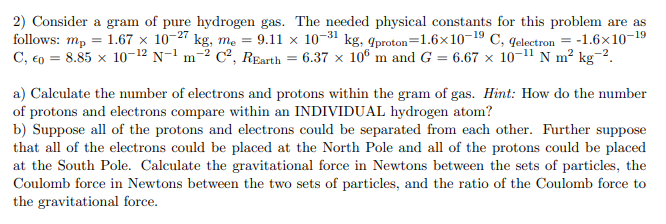2) Consider a gram of pure hydrogen gas. The needed physical constants for this problem are as follows: mp = 1.67 × 10-27 kg, me = 9.11 x 10-31 kg, qproton=1.6×10-19 C, qelectron = -1.6×10-19 C, €0 = 8.85 × 10-12 N-1 m-² C², REarth = 6.37 x 10° m and G = 6.67 × 10-11 N m² kg¯². a) Calculate the number of electrons and protons within the gram of gas. Hint: How do the number of protons and electrons compare within an INDIVIDUAL hydrogen atom? b) Suppose all of the protons and electrons could be separated from each other. Further suppose that all of the electrons could be placed at the North Pole and all of the protons could be placed at the South Pole. Calculate the gravitational force in Newtons between the sets of particles, the Coulomb force in Newtons between the two sets of particles, and the ratio of the Coulomb force to the gravitational force.
2) Consider a gram of pure hydrogen gas. The needed physical constants for this problem are as follows: mp = 1.67 × 10-27 kg, me = 9.11 x 10-31 kg, qproton=1.6×10-19 C, qelectron = -1.6×10-19 C, €0 = 8.85 × 10-12 N-1 m-² C², REarth = 6.37 x 10° m and G = 6.67 × 10-11 N m² kg¯². a) Calculate the number of electrons and protons within the gram of gas. Hint: How do the number of protons and electrons compare within an INDIVIDUAL hydrogen atom? b) Suppose all of the protons and electrons could be separated from each other. Further suppose that all of the electrons could be placed at the North Pole and all of the protons could be placed at the South Pole. Calculate the gravitational force in Newtons between the sets of particles, the Coulomb force in Newtons between the two sets of particles, and the ratio of the Coulomb force to the gravitational force.
Related questions
Question
please show work

Transcribed Image Text:2) Consider a gram of pure hydrogen gas. The needed physical constants for this problem are as
follows: mp = 1.67 × 10-27 kg, me = 9.11 x 10-31 kg, qproton=1.6×10-19 C, qelectron = -1.6×10-19
C, €0 = 8.85 × 10-12 N-1 m-² C², REarth = 6.37 x 10° m and G = 6.67 × 10-11 N m² kg¯².
a) Calculate the number of electrons and protons within the gram of gas. Hint: How do the number
of protons and electrons compare within an INDIVIDUAL hydrogen atom?
b) Suppose all of the protons and electrons could be separated from each other. Further suppose
that all of the electrons could be placed at the North Pole and all of the protons could be placed
at the South Pole. Calculate the gravitational force in Newtons between the sets of particles, the
Coulomb force in Newtons between the two sets of particles, and the ratio of the Coulomb force to
the gravitational force.
Expert Solution
This question has been solved!
Explore an expertly crafted, step-by-step solution for a thorough understanding of key concepts.
This is a popular solution!
Trending now
This is a popular solution!
Step by step
Solved in 3 steps with 3 images
